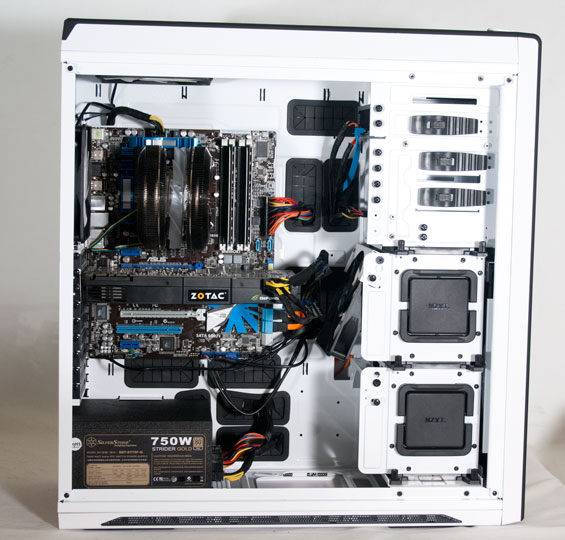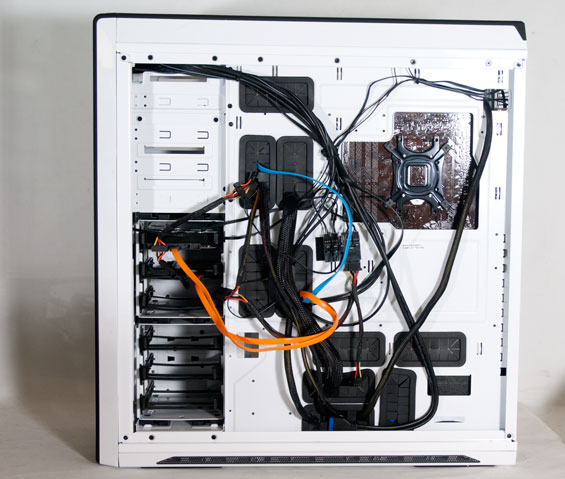NZXT Switch 810: When Too Much Isn't Enough
by Dustin Sklavos on February 1, 2012 7:00 AM EST- Posted in
- Cases/Cooling/PSUs
- NZXT
- Full-Tower
- Switch
Assembling the NZXT Switch 810
Thankfully, putting together a system inside the NZXT Switch 810 is fairly simple and run-of-the-mill. It's a sizable case, but at 20 pounds it isn't woefully unwieldy either. I was disappointed to see the motherboard standoffs weren't pre-installed. This is a little thing and only takes a minute or two, but it's a courtesy some of the other case manufacturers include and I wish NZXT had as well. Popping the I/O shield in was a little more difficult than usual, but that's due to how malformed it is from having been inserted into and removed from twenty cases. Actually installing the board was fine, though, as was wiring everything up.
Installing the drives was easy, too. The bezel for the 5.25" bay pops off without any hassle, and then from there you can slide the optical drive in, lock it into place, then pop the bezel back on. I was impressed at how well the button on the bezel lined up with the drive. Our 3.5" drive pops into a toolless drive tray, but I'm not a huge fan of NZXT's trays: they're flexible in the wrong ways, can be difficult to actually remove, and the pins don't go in as easily as I'd like. Getting our 1TB Western Digital drive in took a bit of force. Thankfully, the 2.5" drive goes in the same way they always do (mounted to the bottom of the drive tray with four screws), but here also lies a problem: the connectors on the back of the drive don't line up with the 3.5" drive above it. Instead, the 2.5" drive is recessed due to how it mounts on the tray. Cabling one while 3.5" drives are installed around it may be a minor nuisance.

Finally, installing the video card and power supply was as easy as you'd expect with a full-tower case, and our GTX 580 offered plenty of clearance for the directional internal fan mounted to the drive bay behind it.

Cabling things was also easy, but it should be mentioned that many of the modular cables we use with our SilverStone power supply were stretched close to their limits. NZXT includes an extension cable for the AUX 12V line (and with all that headroom above the motherboard that line has never been easier to connect), but be forewarned that if you go with the Switch 810 you may need some extensions depending on your power supply.
Our build wound up being reasonably clean, and while I would've appreciated maybe an extra millimeter or two of space behind the motherboard tray, there's still a reasonable enough amount. The side panels didn't require any real pressure to replace. Basically, so far so good: the case is easy to build in and feature rich. So how does it perform?
















29 Comments
View All Comments
Zstream - Wednesday, February 1, 2012 - link
That has better noise control?TerdFerguson - Wednesday, February 1, 2012 - link
Looking at the construction materials, design, etc, I just don't understand how this needs to be selling at $170. Is the price set merely to differentiate from other products? Can't some researcher actually find out what it costs to manufacture such a case? THAT is what I'd like to read. Ditto for motherboards.Morg. - Wednesday, February 1, 2012 - link
Speaking about the price tag ... Why not get a HAF X instead ? I mean there's a bunch of more interesting features, better cooling ... I think NZXT missed the point with this one.And on the other hand .. you can get so much quieter with other cases/. meh.
domezone - Saturday, February 4, 2012 - link
Attempting to justify price tags on logical points such as material costs as well as labor costs is illogical. Any amount of overhead or other middle men taking a cut will raise the price. Beyond a middle man and direct from the manufacture still leaves an overly inflated price point. This is not just for this product unfortunately, I wouldn't assume there are many products or services that actually cost what it costs the company + small amounts of profit.Though if you had questioned a company *any amount of questioning before breaking an arm off in court* the costs would be directly based on employee wages and materials with very modest markups. Guess the research and development costs need to be offset so a computer case set the company back $170 per unit....
no grammar hawks please I know I make errors
cjs150 - Wednesday, February 1, 2012 - link
This is a case designed for watercooling rigs. Massive room up top, and only a little bit of changing allows for a radiator in bottom.The lack of fan control is not a major issue. Lots of motherboards have built in fan control and if all else fails buy a separate controller - not exactly expensive.
My problem with this is simply that it is overpriced and nothing original. Simply example. If case is 235mm wide, would it be better to instal the PSU at tight angles (Lian Li have tried this) rather than conventionally? Makes for neating wiring.
I wonder if NZXT will follow with a smaller case (Switch 610 maybe)
danchen - Wednesday, February 1, 2012 - link
storm trooper !Iketh - Tuesday, February 7, 2012 - link
+1danacee - Wednesday, February 1, 2012 - link
I do not know why they insist upon mounting the PSU on the bottom sucking off the ground, but like bottom mounted freezers on trendy fridges and flat keyboards; it is moronic.Obviously just another cheap ploy to rip off Apple's Powermac and Mac Pro, who unlike these stupid asinine idiot me too PSU case makers; keep the PSU from sucking dirt off the ground and blowing up.
Impulses - Wednesday, February 1, 2012 - link
I believe the idea is to keep it away from the hotter areas (CPU/mem), since hot air rises anyway... Most cases have bottom filters and many users simply don't plant their cases on the floor.I'm not saying I agree with that logic, on a gamer's case the bottom location is bound to be as warm as anywhere else due to the GPU(s), although GPU are under load less often than the CPU (unless the system's used strictly for gaming).
It does seem odd to me that bottom PSU placement is almost universally favored now considering its sometimes a wash as far as temps and it can complicate wiring, but maybe I'm just rationalizing.
Impulses - Wednesday, February 1, 2012 - link
Personally I really dig Silverstone's 90 degree designs, but I haven't gotten around to trying one of them first hand. They're not the most flexible, since they complicate cable management even more and they're not really efficient if you're not using high powered or back vented GPUs, but for a gaming case it seems like the ideal solution... Kind of what BTX should've been.